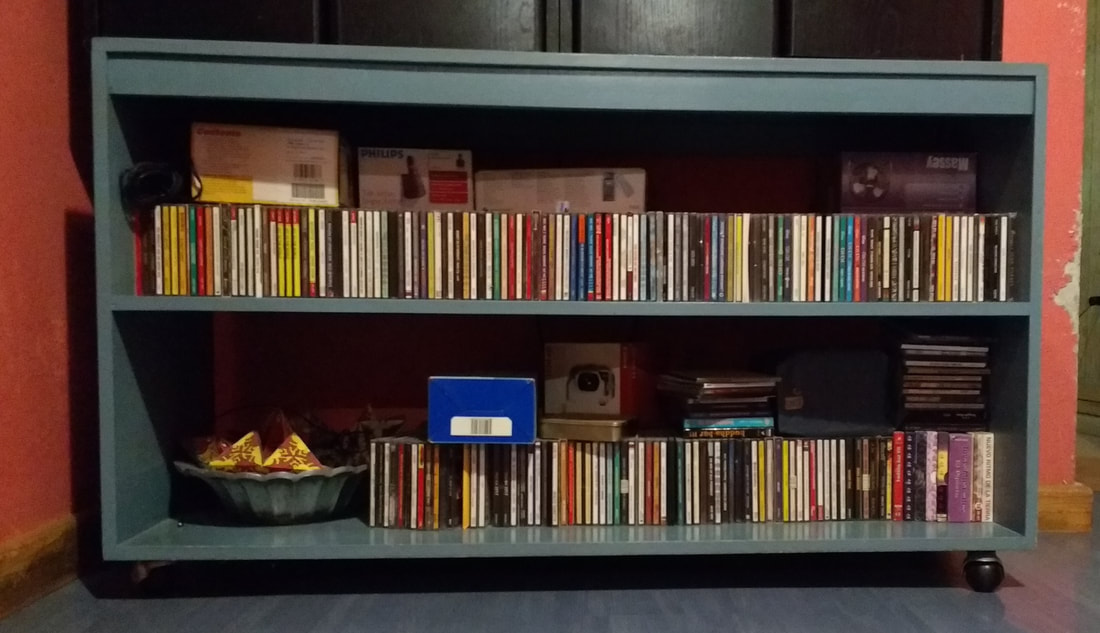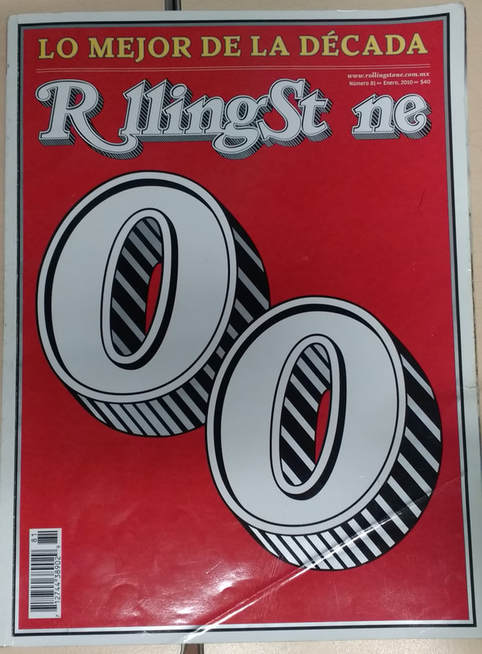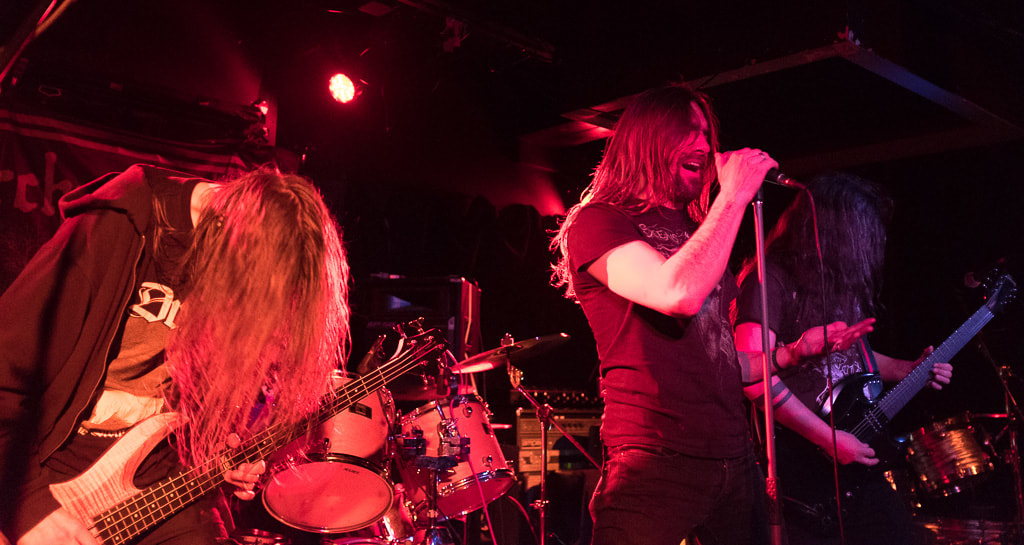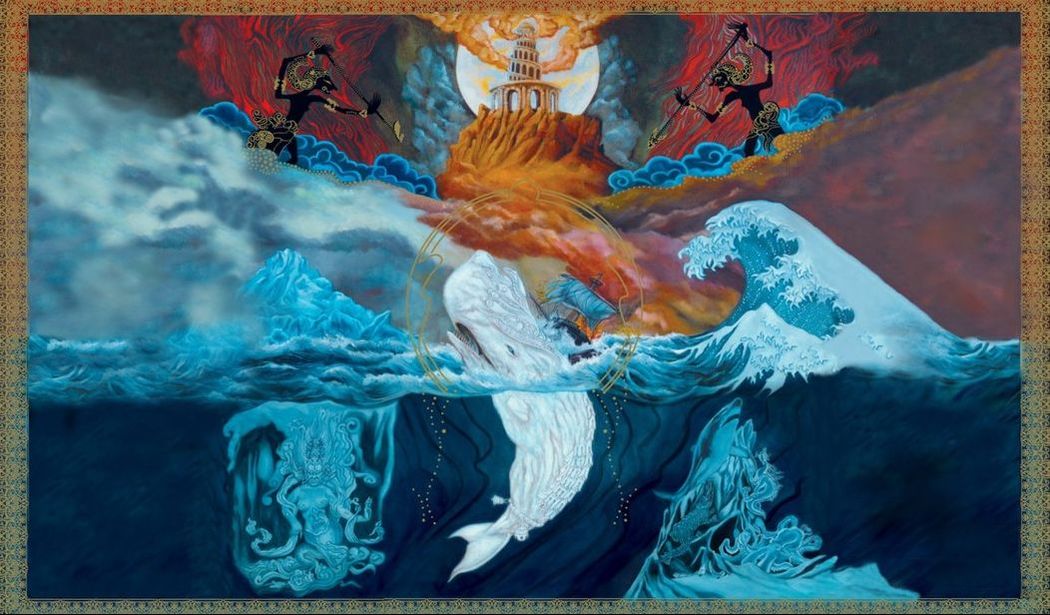|
Written by Noe Loyola From the outside, metal appears to be an impenetrable fortress of terror and suffering. What enjoyment can there be in such a grim place? This genre can offer a cathartic means of finding solace within yourself and the outside world, but getting there without guidance can be a difficult endeavor. Follow along and discover how to traverse the roads that lead to this wonderful realm of musical expression. When I tell people that I love metal, many act surprised. “You don’t look like a metalhead. How can you even enjoy listening to people screaming at you?” These kinds of conversations are habitual and don´t bother me much, but do leave me thinking that the genre is very misunderstood. For many, it is hard to grasp the appeal of hearing a bunch of people screaming as if they were about to expel their guts through their throats (which is understandable). Others believe that by listening to metal I am summoning Satan himself, and get slightly worried about my mental health. I don't blame you if you don't find metal attractive. There are days where I, too, prefer to rest and relax with calmer songs. However, I always go back to metal. Time and time again I realized how passionate I am for this type of music, but I rarely get the chance to share it with others. It is a passion that I am sure you´ll be able to experience as well. I believe the starting point should be my history with the genre. No one wakes up and suddenly says, “Now I understand this shit! I love it!” Metal demands an active effort from the listener and is assimilated in small increments and listening sessions. For me, it began at home, when I was a little boy. My parents enjoyed a variety of musical genres, classic rock being one of the most prominent. One day, my mom thought that it would be a good idea that I watched Pink Floyd's “The Wall: Live In Berlin” concert. I immediately became obsessed with the visuals and music. Each time I returned from kindergarten, I asked her to play it again for me. Other pop and rock albums were part of my childhood, such as “Magical Mystery Tour” by The Beatles and Gorillaz’ first album. Then, I entered secondary school, where I had my first interaction with metal. I listened to what was popular amongst my friends and classmates. Besides listening to a lot of commercial pop and watching MTV, I was introduced to Slipknot, Linkin Park, and Rammstein. Even though some metalheads don’t consider these bands real metal, I beg to differ. Even though I don't listen to them as often anymore, they helped introduce me to different musical styles. I tend to draw a comparison with the concept of gateway drugs, which states that consuming more benign and harmless substances will lead you to try rougher experiences. I believe this to be true for music, as trying simpler forms of a genre can progressively help you understand songs with more complexity. During this period I also began exploring my parents’ CD collection with more attention. This is probably the first time I searched for music on my own, and decided what I liked and what I didn´t. I remember listening to Black Sabbath, Metallica, and Deep Purple while I played “Unreal Tournament 2004” on my computer. Little by little, I amassed a digital collection by burning the CDs into my PC, as well as doing some peer to peer magic in Ares. More time passed and I entered high school. That was the time when my dad gifted me a special edition of Rolling Stone magazine, listing their choice of the best 50 albums and songs of the decade (2000-2010). The magazine introduced me to alternative and indie, with bands like Radiohead, LCD Soundsystem, and Fleet Foxes, which remain with me to this day. But the most important thing is that by reading I realized that a vast musical world existed beyond my parents´ and friends´ tastes. I began looking for recommendations online and increased my collection very quickly. While browsing, I read and followed blogs and reviewers that introduced me to new music. Some of them, like Pitchfork and The Needledrop, reviewed metal albums from time to time. These were much heavier and experimental than the ones I listened back in secondary school. I attempted to enjoy them, but instead suffered and slogged through their runtime. They were too extreme for me. But one day, while getting lost on Youtube for hours, things changed. I stumbled upon Opeth´s “Ghost Of Perdition.” Their music combines melodic and harsh vocals and transforms continually with diverse passages and sections. I can only say that I was blown away. Thanks to their friendlier style, I could ease myself into the appeal of extreme metal and discovered the wonderful creativity and potential of the genre. From that moment and to this day, I have investigated and discovered more and more metal albums and artists. I familiarized myself with the massive amount of subgenres, such as death, black, doom, progressive, power, symphonic, and many more. I was impressed by the diversity of sounds that existed, and I still find new surprises constantly. What is it that has provoked such a fascination on me? Metal is one of the most emotional styles out there. No matter which subgenre you pick, the music is filled with energy. The range of emotions presented by this style are the ones that scare us the most. We always make an effort to make happiness our main sentiment, but we hardly feel that way all the time. We can feel the pain of losing someone we love, struggle with depression or feel nostalgic about some moment of the past. Many times we are surrounded by egotistical and unpleasant people, as well as by unfair situations that make our blood boil. School, work, relationships, existential crises, traffic jams, and many other things in our daily lives drain us and fill us with stress. These feelings are difficult, relevant, and most importantly, real. Metal is the means through which I can channel these emotions, as well as a gateway to understand how other people that feel the same way, express them. This genre has helped me understand and feel more comfortable with the concept of depression. By listening to Triptykon´s “Melana Chasmata” whilst reading the liner notes from the CD, I discovered the tormented reality of vocalist Tom G. Warrior. I had a very clear and vivid image of despair by listening to Leviathan´s “Aphōnos.” I lived under Jef Whitehead´s skin for a moment thanks to the power of his echoing, tortured wails and to the song´s dense and somber atmosphere. Other artists opt to introduce us to nightmarish realms that provoke fear and welcome us to explore the unknown. Sunn O))), with their album “Black One,” present an experience of absolute and all-encompassing horror. Listening to it with the lights out was an adventure both frightening and rewarding. Imperial Triumphant, with their twisted and eccentric songs, create a sentiment of disgust that makes one wonder how is it possible to create sounds that are so nauseating. In the same way that we enjoy watching horror movies to be thrilled, metal can provide a similar experience in auditory format. Sometimes it can be even more powerful, as it allows our mind to shape the music in ways the darkest depths of our imagination can muster. The parallel with horror movies can also be drawn with the subgenres of metal that deal with wrath and violence. Styles such as brutal death metal attempt to create aggressive sounds and murderous subject matters. This is equivalent to watching a gore film or a classic slasher with a psychopath chasing innocent high school students. Even though this type of material is grotesque, we know it is fiction. This allows us to experiment with scenarios that happen within the depths of our mind without harming anybody. Listening to Cannibal Corpse or Carcass is a brutal and liberating experience. Given its extreme nature, metal is mostly played rapidly and aggressively. This gives it an invigorating nature that helps let out our bottled feelings of frustrations and anger. I remember a day in particular when I was feeling very stressed by college. I had been working nonstop to finish four projects, of which half didn’t interest me at all. And because life loves to complicate things, my mind was invaded by recurring thoughts of my ex. In that instant, I felt alone, sad and frustrated. I decided to give myself a small break to tell life that it could go fuck itself. I played Nails’ “You Will Never Be One Of Us.” In its short, 21-minute runtime, the album worked like a shot of adrenaline. I went apeshit and forgot about my problems. When the last song faded away, I felt calm and content. It was an incredible moment of catharsis. I don’t have experiences as intense as this one all the time, but the raw energy of metal always helps me achieve a calmer state of mind. But not all of metal consists of negative emotions. Some artists opt to portray beauty and awe. Agalloch, with their use of acoustic elements and delicate arrangements, showcase the allure of nature and our insignificance in comparison to its staggering size. Others, like Opeth, seek to generate elegant sounds in coexistence with heavy elements. By introducing clean vocals and meditative passages, the compositions earn fascinating and unique qualities. Other subgenres, like power metal, place us in the shoes of warriors who fight in epic battles against mythic beasts and ancient gods. The complete absence of horrifying elements allows the music to transform us into kids once again. The possibility of adventure offered by these songs induces happiness and wonder. The heroic choruses invite us to sing out loud while we launch ourselves into the eye of the storm that is the fight to eradicate evil. Listening to bands like Blind Guardian or Angra is always fun and exciting. This wide emotional spectrum is probably the main reason why metalheads are, for the most part, very relaxed individuals. Contrary to what the tattoos, piercings, terrifying music, and black clothes might lead you to believe, the people that create and listen to it are very friendly. I have gotten to know many members of the metal community in Seattle. Most of them are humble, open minded and eager to share and receive musical recommendations. No matter how small the group of people is, a strong sense of community is always present. I have felt it at almost any place I’ve been to that is related to the genre. When I visit forums and blogs, people participate actively, discuss music with passion, and form friendships. Some of the blogs I visit regularly always have comments on their reviews, no matter if the album is a masterpiece or an insult to humankind. I also see familiar faces years after following the same site, which demonstrates to me a strong loyalty and passion from the metalheads. Ever since I moved to Seattle, I had the opportunity to immerse myself in a big metal community for the first time. I have attended a variety of shows and bars where I’ve met both fans and musicians (which are also fans!). I noticed how they helped each other by attending concerts, offering space in venues and always being friendly to each other. As most shows take place in small venues, such as dive bars or even houses, the events become an intimate space where musicians become part of the audience. When they aren’t up on stage, most of the group members are either enjoying the performance of the other groups or selling t-shirts, stickers, albums, and patches in a merch table. Each time I approached their small band shop, I had warm conversations about their music or their cities. I never felt pressured to buy anything, and even if I just bought five dollars worth of stickers, they were always grateful for my contributions. What impressed me the most is how bands supported themselves during tours. Ticket prices for many shows were at most 15 bucks, in which up to four acts played. Merch was also reasonably priced, dare I say underpriced, most of the time. Even though earnings seem to be barely sufficient to sustain the tour, the artists decide to travel across the country packed like sardines in a small van, eager to share their music with the world. For me, this is an undeniable proof of passion and love for their art. Then, where does the idea of metalheads being agents of evil that sacrifice goats come from? These ideas and aesthetics come mostly from black metal, a style that showcases some of the most extreme attitudes of the genre. Though many performers only exhibit these ideas in a purely theatrical and expressive sense without ever harming an animal or human, infamous cases do exist. For example, Varg Vikernes, the mind behind Burzum, is known for having burned several ancient churches in Norway, as well as for murdering another musician of the scene nicknamed Euronymous. As in any discipline or art form, people who take their ideas to another level always exist. Controversy is inevitable, and sadly it is what always appears in news headlines, obscuring the positive output of other members of the community. In the end, it is the choice of each listener if they wish to consume the art of unethical and scandalous artists. On the other hand, the genre is filled with respect for the major part of its representatives. One of the stellar examples is Chuck Schuldiner, singer and leader of Death, as well as a pioneer in the subgenre of death metal. Chuck began writing songs about violent and bloody stories. Later, he introduced social criticism into his lyricism, to finally step into more philosophical themes. In contrast to the aggressivity of his music, Chuck was described as humble human being in love with life and animals. Unfortunately, he passed away when he was 34 years old due to brain cancer. If you visit any video of a Death song on Youtube, it is likely that you will find comments reminiscing about him and paying him respects. Last but not least, metal is a genre where originality and experimentation thrive. Given its extreme and non-commercial nature, this style incites its musicians to take risks and explore uncharted territory. Like in any other genre, more commercial and accessible variants exist that are helpful for becoming introduced into this world. However, these pale in comparison to the diverse ecosystem that is the underground. Metal takes musical experimentation to the extreme. It is in the search of the fast, slow, heavy, horrifying, suffocating, and many more descriptors. Some of these sounds may not be pleasant, but this breaks with the idea that music should only consist of melodious sounds. Using dissonance or abstract sounds results in works that have a hefty emotional impact and that channel a message more effectively. Metal is also intrepid because it doesn’t shy away from taking elements from other styles and merging with them. Concoctions composed of symphonic, electronic, folkloric, noise, and rap elements abound. No style escapes from metal’s experimentation. And perhaps one of the most similar is classical music, which also constantly seeks to expand horizons and stay at the vanguard. Some studies even suggest that metal fans are almost identical to those of the age-old genre. The lyrical content is also original and imaginative. Metal songs always fill me with wonder and curiosity for new topics. Gorguts’ “Colored Sands” introduced me to Tibetan culture and Buddhism. Nechochwen made me curious about the history and mythology of Native Americans. Deathspell Omega, with their complex themes and bizarre take on religion, inspired my interest in reading the Bible. Vektor impressed me with their album “Terminal Redux,” which narrates an enthralling science fiction story. Gloryhammer made me giggle like a schoolgirl with their satire of the subgenre of power metal. The topics touched by the genre are infinite and fascinating. I always take away new learnings and surprises. It is also worth mentioning that a big chunk of album artwork is often worthy of admiration on its own. Many musicians search to portray the bizarre, beautiful, or fantastical of their work in the graphical art of their records. Because of this, it is a delight to purchase physical copies, which contain even more details and nuance in their booklets and liner notes. And though some covers are absolutely abhorrent, most of them are an essential complement to the music. All of these are the reasons why metal has captured my heart. Probably many more exist, but I do not know how to put them into words yet. It is an experience that needs to be lived, and even though the investment required to appreciate the style is considerable, the payoff is worth much more than the price of admission. The energy that its songs transmit, the catharsis it provokes, the fascinating topics of its lyrics and the novel sounds it showcases fearlessly have made it an essential part of my life. It has allowed me to enjoy music much more, regardless of the genre, making me more open to trying new things. In short, it has given me the power to transform fear into curiosity; a beautiful lesson that makes my life in this planet much more wholesome and meaningful.
1 Comment
Brian
6/14/2020 09:24:42 pm
I read this whole blog post aloud to my friends via video chat, and we all loved it!! Thank you so much for the metal!
Reply
Leave a Reply. |
Categories
All
Blog Archives
July 2024
|






 RSS Feed
RSS Feed